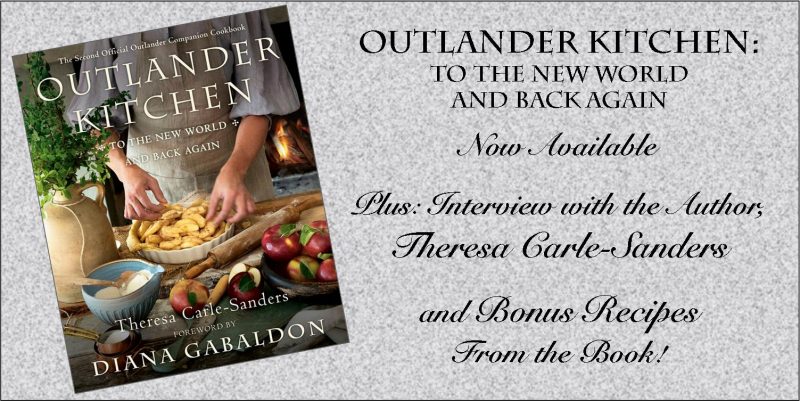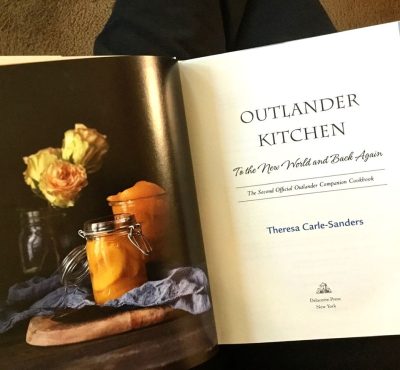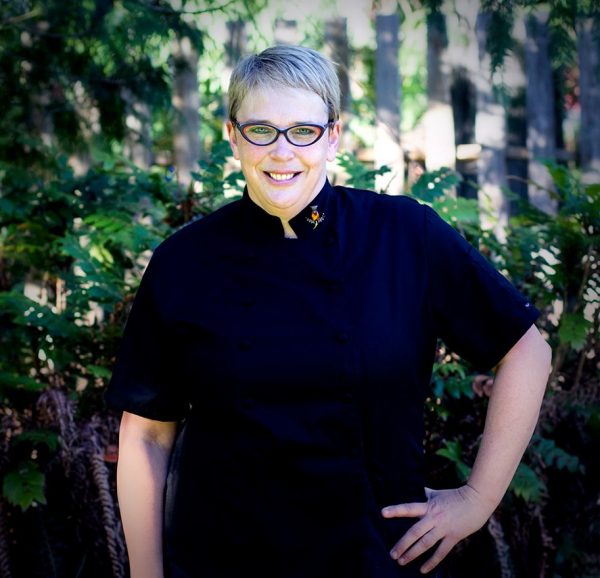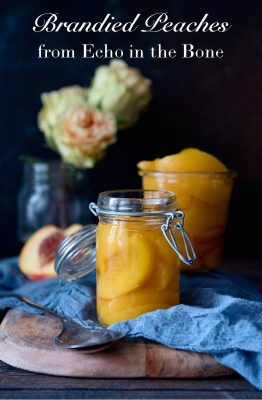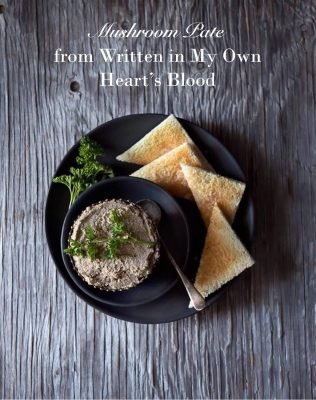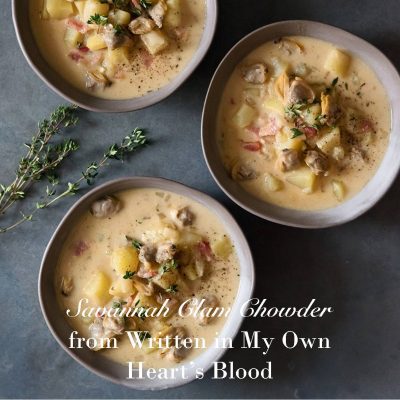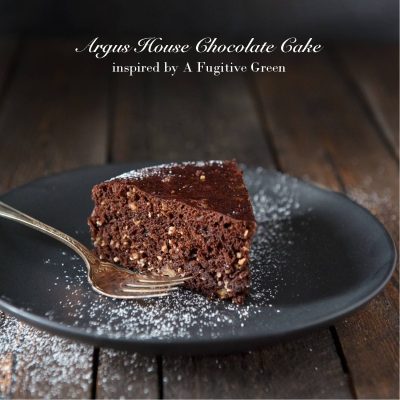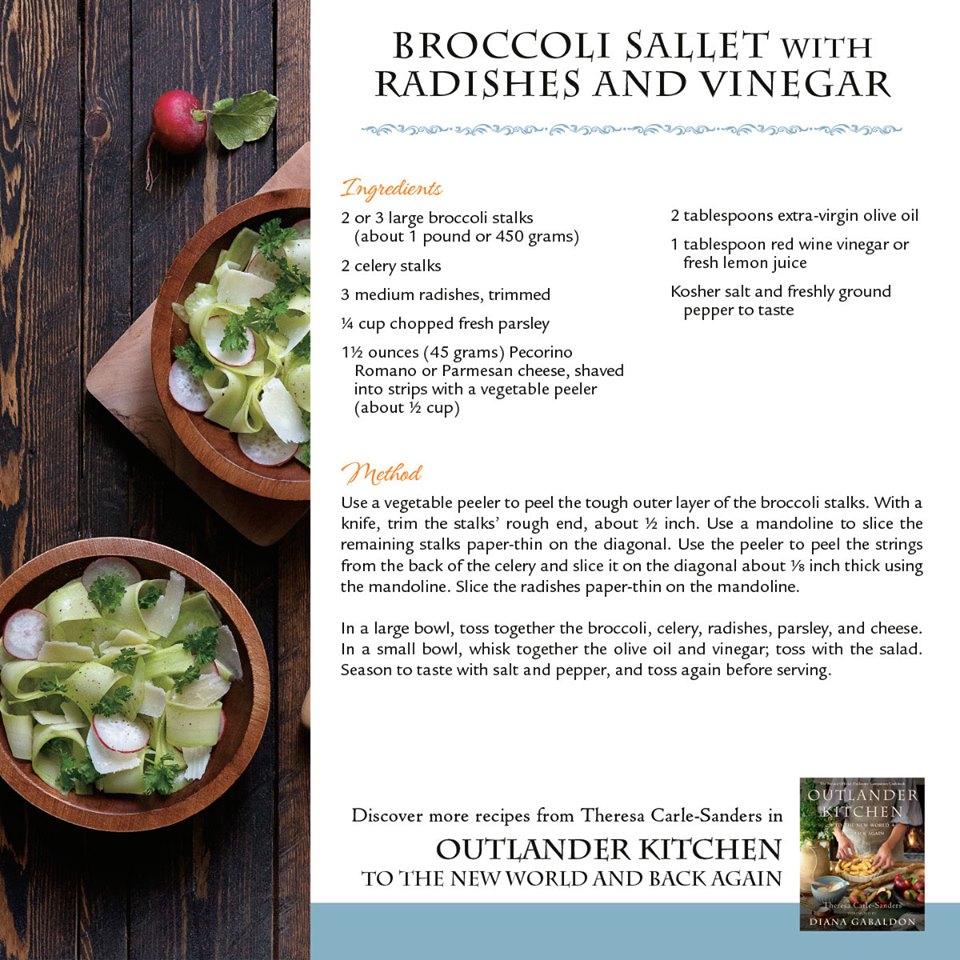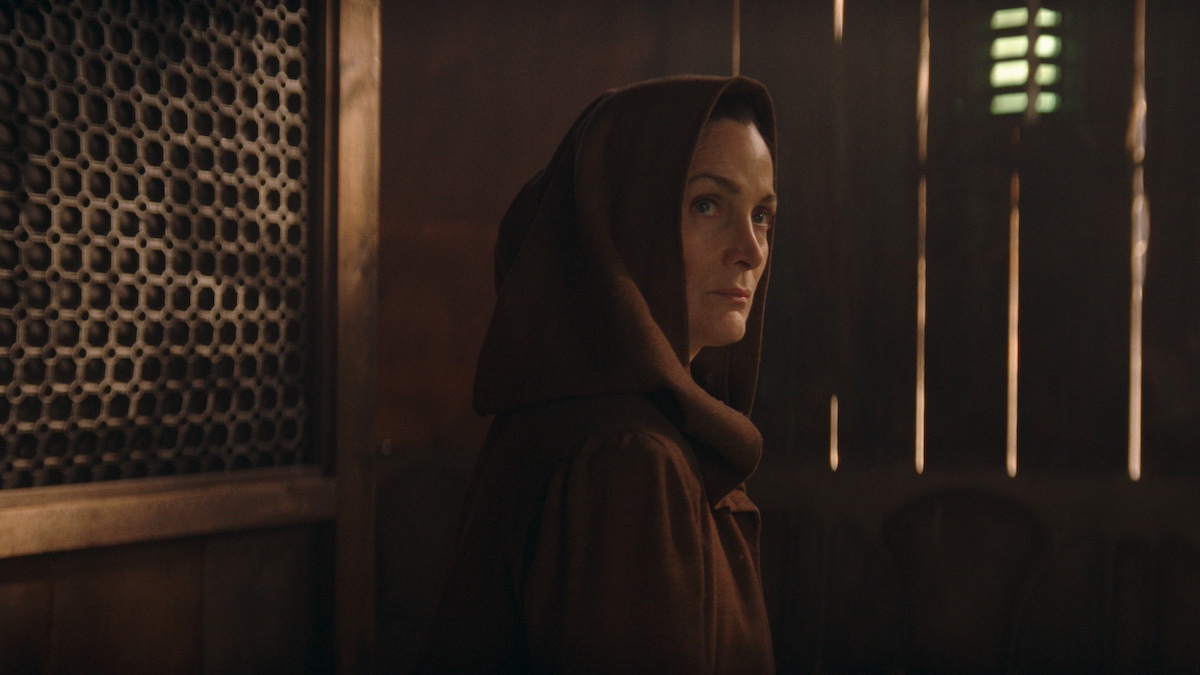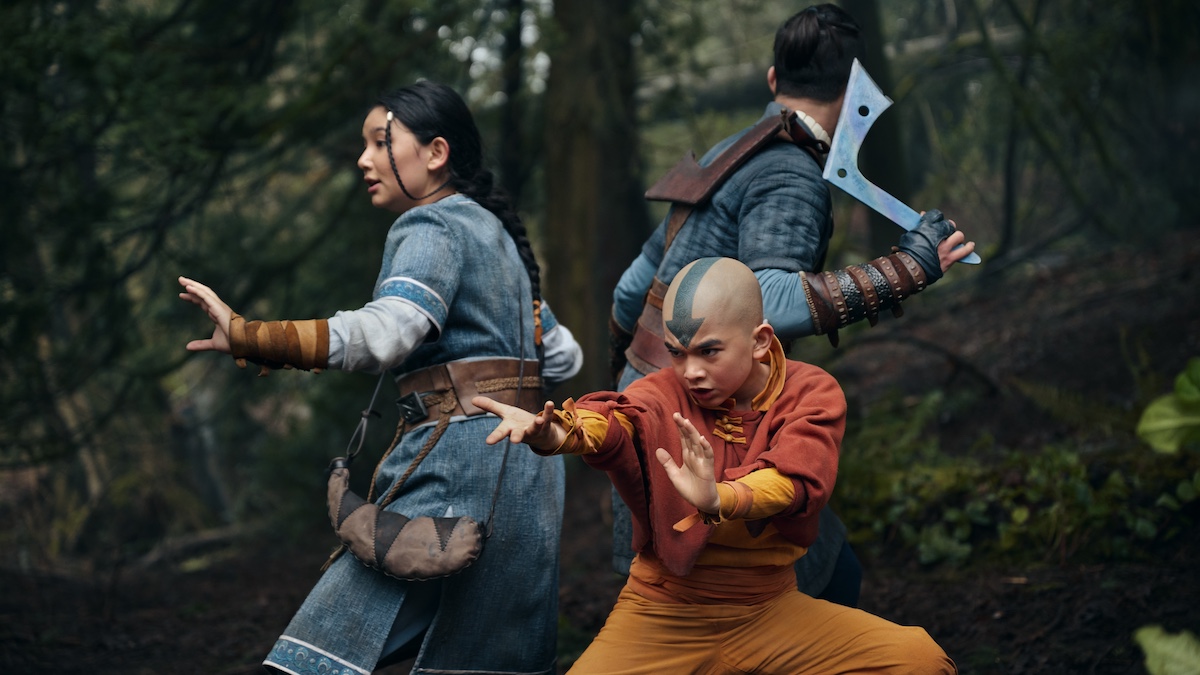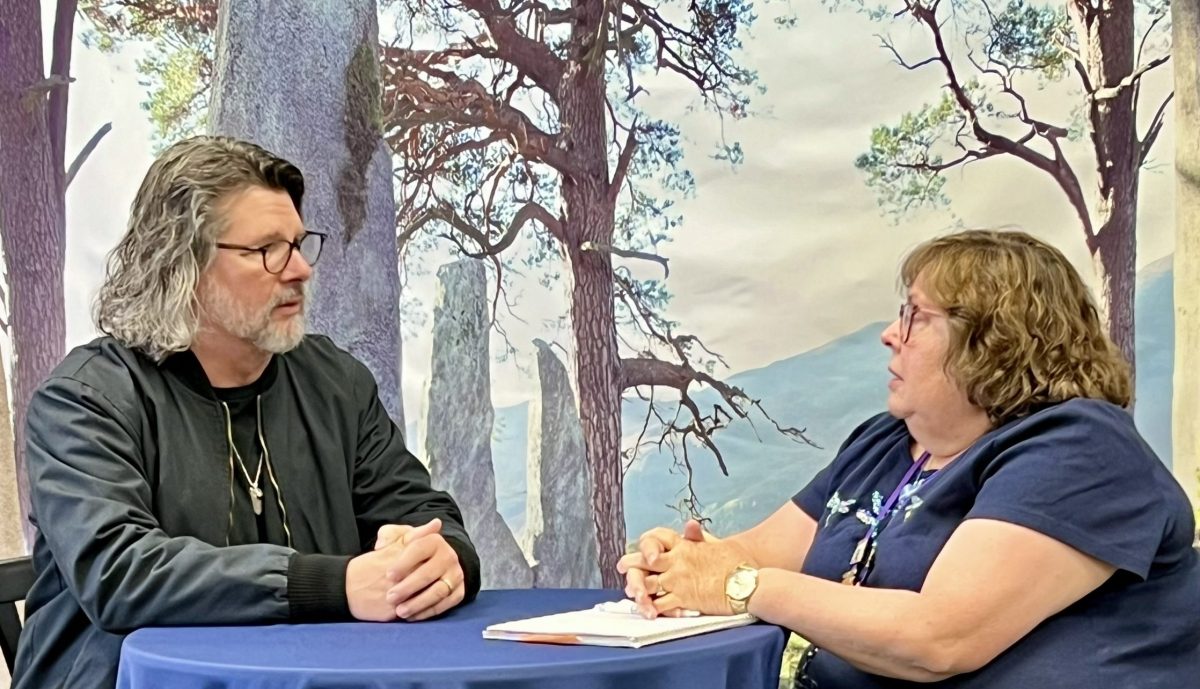One thing we all appreciate about Diana Gabaldon’s books is her attention to all the senses – sight, sound, touch, along with taste and smell. One way she grabs us is through her passages about food. And of course, us Outlander devotees want to walk with Jamie and Claire, even down to what they eat. So Theresa Carle-Sanders, author of 2016’s Outlander Kitchen cookbook, has done it again with her brand new Outlander Kitchen 2: To The New World And Back Again.
OK2, like its predecessor, is a big beautiful book, full of fantastic recipes, mostly created by Theresa from food mentioned in Diana’s most recent three books (A Breath of Snow and Ashes, Echo in the Bone, and Written in My Own Heart’s Blood), as well as the Lord John Grey series and the novella compilation Seven Stones to Stand and Fall.
As Theresa discusses below, something that makes this book unusual – and welcome to many home cooks – is her adjustment for each recipe for those who follow vegan, vegetarian, dairy- or gluten-free diets, where possible. And she also includes a set of basic recipes – mayonnaise, vegan cream, crust for tarts or pie, simple syrup, and others. So everyone from the new cook to the experienced and experimental can successfully make her recipes.
Yesterday, Theresa filmed a short cooking class with Lauren Lyle and John Bell, which will be made public in August (no date set yet). She demonstrated a recipe while they asked questions – and you can be sure, with those two, that it will be a must-watch! We don’t know what it is that she cooked with them, but I’m sure it was fabulous.
We talked to Theresa on the Outlander Gab, our internet radio show, in April. You can listen to the entire interview with me, Samantha Kraupner and Alyson Bailey, as well as the callers who got to chat with her, here. But here’s the bulk of our interview (occasionally paraphrased), to give you some background on the book and Theresa’s process.
Specifically for the radio broadcast, Theresa provided us with one of the book’s recipes, and you can still download that – Chicken and Cornmeal Stew – here!
The recipes all follow a structure – there’s a piece from one of the Outlander books, from where you have based the recipe, notes on the food itself, the ingredients and method, and notes for those with dietary preferences or restrictions. That’s exactly right. I read through all the books and pick out the food. Once I’ve picked out all the food, I go back and look through all the excerpts and make sure its a – most of the time I make sure it’s full of Fraser family sitting around, or something funny is going on.
Did you find a big difference in recipes since you did the first book? They weren’t all Scot based, some from Voyager, different in the types of food you were putting in the second book? Recipes were along the same lines, I go and look for historical equivalent recipes for foods. Sometimes the historical recipes are good, and turn out delicious. But not all of the time. A lot of the time, they’re not suited for our palates anymore. I make some changes. Some are updated a little bit, sometimes i take off in a different direction. I did the same thing this time. In all those stories (that this cookbook is based on), there’s a lot of going back and forth between Europe and the New World, and back and forth in time. The title plays on both.
I don’t really cook, but love looking through the book, love looking at recipes and excerpts. and seeing how they fit together. Did you get feedback from readers that made any difference in how you put the second one together, or had your formula (from the first book) worked? I liked the formula I had, it worked really well, but I certainly listened to feedback, which was overwhelmingly positive, so I kept doing the things that worked well for people. Some are more intricate and more involved than others, but I tried to lay them out in a simple step by step manner that’s easy to follow for any level of cook. But this time, I also went toward focusing on specialized diets – vegan, gluten free, dairy free. I added little tips on each recipe so that more people can use the recipes. There are lot more vegans and vegetarians in the world, and it’s not a phase, it’s really a direction and a trend that’s going to keep on. I’ve had lots of requests for vegan recipes. For example, in the second cookbook, there’s “mocktopus,” it’s a play on octopus with tomatoes and olives, from when John Grey is in the Caribbean. So it’s made from a Chinese mushroom, and when you grill that mushroom it’s really chewy, so it’s the exact texture of octopus. There’s also a recipe for squid in the book, and I use a real squid for that one. so you can see I’m trying to get everyone to cook a little more Outlander.
OK had been your first cookbook. Were there things that you found doing that that surprised you in the whole process of putting it together? The biggest surprise was just how much freedom Random House gave me to write it. Generally cookbooks are managed pretty tightly by the editor, and there’s a definite formula that each publication house uses, but my editor is actually a fiction editor, she’s not a cookbook editor. So we figured out a lot of things along the way between ourselves the first time. And the second time, she really let me at it, and she’s always there if I have a question. But it’s not the same as, say, going to RH ‘s Appetite publishing house, where it’s all cookbooks. It would be a much different experience, and I’m not sure I could handle it, after having been given all of this freedom.
The cookbook is based off of fiction books, they know how Diana writes and they want it to fit with that part of it. Yes. So my editor is in Diana’s editor’s office, they all work together. The font is the same, and yes, exactly.
Did you use fans as testers? I know you did that the first time. I actually used the same group of testers, and they all graciously said they’d do it again, and I was thrilled, because it worked so well the first time. They each tested 3 recipes a week for 6 weeks, and there are 10 of them, so that’s 180 recipes. So I had multiple tests of each recipe. Which is really great feedback, because there’s always a typo. Writing a cookbook, I always say it’s going to age me. It’s like writing a repair manual. It’s technical writing, and it’s always the same. You’re always writing a repair manual, but it’s for Toshiba, or it’s for Sony, and they’re all laid out the same. It can actually get really mind numbingly dull when you’re doing all the data entry. It’s a very technical thing, so it’s nice to have all those eyes to look over before I send it in to the publisher.
Did you use the same photographer? Yeah! Rebecca from Victoria. I live on Pender Island, which is between Victoria and Vancouver on the west coast of Canada. Rebecca lives just about a 45 minute ferry ride away from me. It was a thrill to use her again, because she takes such beautiful pictures. And she also did the cover again.
You did a series of FB lives. My husband and I started social distancing on March 12. Over that weekend, I decided it would be fun to do sort of a Pandemic Pantry kind of live show, cooking from what you’ve got in your pantry. Most of it is Outlander themed. We did one that was not Outlander themed, it was making risotto, but I did not have Italian rice, so we used sushi rice; you could use barley…. Sushi rice and Italian rice are actually almost the same, about the same amount of starch. But you could use barley, you could use millet, farrow, almost any grain. Time to clean out those pantries and see what you’ve got in the bottom. (There are 5 videos, all on the Outlander Kitchen Facebook page.)
(Alyson) I followed the cherry bounce experiment since the beginning of the blog – I didn’t make it every year, but I bottled it up, and quite a few family members expect it. Thank you for supporting the blog for so long! That was before the show. That was when I was told that it would never ever be a cookbook. Then the show changed everything. In more ways than one, didn’t it!
The blog is fun to look through – outlanderkitchen.com. You can search through the recipes by book, or by ingredient. You don’t have to cook to enjoy Outlander Kitchen, I think I’ve sold a few thousand of those book to people who don’t cook at all. The pictures are really beautiful, and when you tie it all together, I think people really enjoy looking through it in bed, believe it or not, but that’s what I’ve been told.
In the first book, Diana wrote the foreword, and she’s done that again. What kind of relationship do you have with Diana? Diana’s been supportive of OK from the very beginning, since 2010. She’s not as accessible as she used to be, of course, in the beginning, I wrote her – I had gone for a walk in the woods, and thought of a recipe I’d like to make, and I sent her an email – I sent her Canadian publicist an email, and she got back to me the very next day. I don’t think that would happen now. When I email to ask her questions – and I try to make them quick,and try to answer them myself before I go to her – she always gets back to me. She’s polite and professional, and I really hope we get to do a signing at the Poisoned Pen together when all of this is done again.
Her foreword with your book was quite interesting, and I’m looking forward to the new one coming up. She does seem to be very generous with her time and her encouragement. She is. She leaves a great legacy, she’s given a lot of people a lift up, and a step up, including myself. I’m very grateful for all the help she’s given me.
What makes a vibrant, thriving culture? The language you speak, the stories you tell, the songs you sing, and the food you eat. And when people are forced to leave their place of origin, they often take these precious things with them.
If you hang around in Scottish academic circles these days (and who doesn’t …?), you hear a lot about the Scottish diaspora. This refers to the Scots (both Highland and Lowland) who – over a period of some three centuries – emigrated from Scotland and settled in other parts of the world. Some went willingly to find new opportunity and adventure, some were transported as prisoners, and some left because their homeland could no longer support them. (from Diana Gabaldon’s Foreword, Outlander Kitchen 2)
Do you have a favorite recipe in this book? I do. I think, soup. Scotch broth. I’m a simple girl at heart, and I think the Scotch broth is a really beautiful, down homey recipe that’s going down really well around here right now. You kind of don’t have to eat as much when you don’t go anywhere, do you? Although I think we’re all guilty of, when we’re shopping, the junk food in the cart – at least in my cart anyways – is out of control. Lot of comfort food eating. And the other one I really is a strange little one, it’s White Chocolate House, from one of the Lord John books. I made it up. It’s a modern recipe. So it’s really white chocolate cinnamon rolls, but I’ve called then White Sugared Morning Buns, and they’re filled with cinnamon, and white chocolate and all kinds of other really gooey things, and if you like baking, you’ll probably really like those.
Just for Three If By Space readers – Theresa provided an as-yet-unreleased recipe card from Random House. Feel free to print this out and make it!
Outlander Kitchen 2: To The New World and Back Again is available from Barnes & Noble, Amazon or by order from your favorite local bookstore!
Join us on Facebook at Outlandishly Three If By Space
Follow me on Twitter: @ErinConrad2 and @threeifbyspace
Like this article? Share it with our Social Share buttons!
Subscribe for instant notice of new posts

